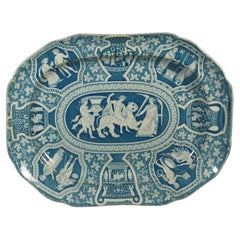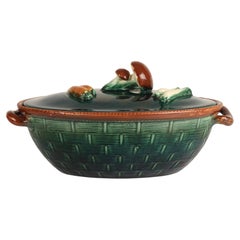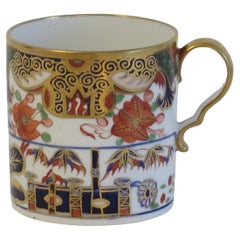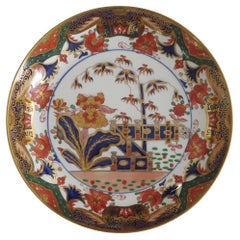Georgian Ceramics
7
to
1
6
1
7
7
7
7
4
1
7
7
5
2
2
7
7
7
41
10
7
7
7
Style: Georgian
Creator: Spode
Georgian Spode Coffee Can Porcelain Pattern 1928, circa 1810
By Spode
Located in Lincoln, Lincolnshire
This is a very good quality porcelain coffee can by Spode of Staffordshire, England, made during the very early 19th century, George 111rd period, circa 1805.
The coffee can is no...
Category
Early 19th Century English Antique Georgian Ceramics
Materials
Porcelain
Spode Porcelain Serving Platter or Dish Hand Painted & Gilded Ptn 967 circa 1810
By Spode
Located in Lincoln, Lincolnshire
This is a fine example of an English George III period, porcelain serving platter or dish, made by Spode and hand painted in Pattern 967, during the early 19th century, circa 1815.
...
Category
Early 19th Century English Antique Georgian Ceramics
Materials
Porcelain
Spode Porcelain Tea Cup in Hand Painted & Gilded Pattern 967, circa 1810
By Spode
Located in Lincoln, Lincolnshire
This is a fine example of an English George III period, porcelain Tea Cup, made by Spode and hand painted in Pattern 967, during the early 19th century, circa 1815.
The cup has th...
Category
Early 19th Century English Antique Georgian Ceramics
Materials
Porcelain
Spode Porcelain Sucrier Hand Painted and Gilded Pattern 967, circa 1810
By Spode
Located in Lincoln, Lincolnshire
This is a fine example of an English George III period, porcelain, Sucrier with cover or lidded sugar bowl, made by Spode all hand painted in Pattern 967, during the early 19th Century, circa 1810.
This Sucrier has a beautiful and elegant shape with high loop handles either side of the oval body. The cover has a shaped oval knob...
Category
Early 19th Century English Antique Georgian Ceramics
Materials
Porcelain
Georgian Spode Coffee Can Ironstone Kackiemon Pattern 2117, circa 1820
By Spode
Located in Lincoln, Lincolnshire
This is a good stone China (Ironstone) coffee can made by the SPODE factory in the early 19th Century, circa 1820.
The coffee can is well potted with cylindrical shape and a loop handle with the distinctive Spode kink to it. The piece is beautifully decorated with hand painted enamels in the chinoiserie Kakiemon style, pattern number 2117.
It has the Spode Stone China blue printed...
Category
Early 19th Century English Antique Georgian Ceramics
Materials
Ironstone
Georgian Spode Pen Tray 0r Lidded Box Ironstone Willis Pattern 2147, circa 1810
By Spode
Located in Lincoln, Lincolnshire
This is a good stone China (Ironstone) Pen Tray or Box with lid, made by the SPODE factory in the early 19th Century, circa 1810.
This piece comprises a base and a lid both made fro...
Category
Early 19th Century English Antique Georgian Ceramics
Materials
Ironstone
Antique Spode Ornithological Miniature Chamberstick
By Spode
Located in West Palm Beach, FL
Antique Spode Ornithological Miniature Chamberstick
With rich apple green background, with gilt ring handle, painted with a vignette of a Whinchat in l...
Category
Early 19th Century English Antique Georgian Ceramics
Materials
Porcelain
Related Items
Large Spode Greek Pattern Platter Circa 1810
By Spode
Located in Ottawa, Ontario
Large Spode Greek Pattern Platter
Circa 1810.
14 5/8" in. (37.2 cm) long.
11 3/8" in. (28.9 cm.) wide.
Printed in blue underglaze
on an indented earthenware platter.
Central scene is showing Bacchus with entourage.
He is riding on a panther symbolizing his conquest of India.
The image is based on a print published in
M.W. Tischbein, 1791
“Collection of Engravings...
Category
Early 19th Century English Antique Georgian Ceramics
Materials
Porcelain
1930’s Belgium Ceramic Basket Casserole with Vegetable and Mushroom Lid
Located in London, GB
A wonderful Casserole bowl or dish with integral lid, produced in Belgium, circa 1930. A ‘Tellurite’ model number -1125- lidded tureen with basket weave sides in rich, deep earth ton...
Category
1930s Belgian Vintage Georgian Ceramics
Materials
Ceramic, Pottery
H 7.09 in W 15.16 in D 9.26 in
1930s Susie Cooper Modern Grape Leaves and Grapes Pattern Breakfast Set, England
By Susie Cooper
Located in Miami, FL
Susie Copper's 1930s Breakfast / Luncheon set of 8 Demitasse cups / saucers and 12 plates in blue background and white hand painted underglaze decoration of Grape Leaves and Grapes. ...
Category
1930s English Vintage Georgian Ceramics
Materials
Ceramic, Pottery
Spode Porcelain Teacup, Imari Tobacco Leaf Pattern 967, Regency ca 1810
By Spode
Located in London, GB
This is a beautiful teacup and saucer made by Spode in about 1810. The set is decorated with the famous Imari Tobacco Leaf pattern 967, which was first introduced by Spode in 1806.
...
Category
1810s English Antique Georgian Ceramics
Materials
Porcelain
Free Shipping
H 1 in W 1 in D 1 in
Antique Early 19th Century Spode Porcelain Pattern Number 2408 Tea Cup & Saucer
By Spode
Located in Philadelphia, PA
A fine antique Spode porcelain cup & saucer.
Pattern no. 2408
Decorated throughout with a cobalt floral patttern and extensive gilding.
Simply a great cup & saucer from Spod...
Category
Early 19th Century English Antique Georgian Ceramics
Materials
Porcelain
Large Blue and White Spode Greekware Platter England Circa 1810 Neoclassical
By Josiah Spode
Located in Katonah, NY
Spode made this fabulous platter circa 1810.
It is decorated in the neoclassical "Greek" pattern with classical figures and mythological scenes based on ancient Greek and Roman art. It is large, measuring 20" x 15.5" x 1.75" deep, and is perfect for hanging.
The dramatic pattern shows a scene from Olympic history.
At the center, Cynisca wins the four-horse chariot race at the Greek Olympic...
Category
Early 19th Century Antique Georgian Ceramics
Materials
Earthenware
H 15.5 in W 20 in D 1.75 in
Spode Porcelain Teacup Trio, Red Imari Dollar Pattern, Regency, ca 1810
By Spode
Located in London, GB
This is a beautiful orphaned teacup made by Spode in about 1810. It bears a beautiful Japanese-inspired Imari pattern.
Spode was the great pioneer among the Georgian potters in England. Around the year 1800 he perfected the bone china recipe that has been used by British potters ever since, and he was also the leading potter behind the technique of transferware, making it possible for English potters to replace the Chinese export china, which had come to an end around that time, with their own designs. This was fundamental to a thriving industry that would last for about 150 years and provide half the world with their tableware. Spode porcelain is regarded as one of the highest quality porcelains around; for a soft-paste porcelain it is surprisingly hard and fine, and has a wonderful bright white colour.
The pattern on this can is called "Dollar" pattern, a very famous pattern that was used by English potters in the 18th and early 19th Century. It is obvious why it is called “dollar” - but its origin is less obvious! It is thought that this pattern was derived from a very old Chinese pattern depicting a tree with elaborate foliage that hides a Chinese character representing longevity or happiness. Traditionally, this went with a an image called “Taotie”, which was used on very ancient bronze vases...
Category
Early 1800s English Antique Georgian Ceramics
Materials
Porcelain
Free Shipping
H 1 in W 1 in D 1 in
Spode Teacup and Saucer, Red, Gilt with White Chrysanthemum, Regency ca 1810
By Spode
Located in London, GB
This is a beautiful teacup and saucer made by Spode around 1810. The set is shaped in the "bute" shape and decorated with a bright Neoclassical pattern of a warm red ground with gilt...
Category
1810s English Antique Georgian Ceramics
Materials
Porcelain
Free Shipping
H 1 in W 1 in D 1 in
Mason's Ironstone Japan Pattern Vases, a Pair
Located in Downingtown, PA
Mason's ironstone Japan pattern pair of vases,
circa 1830-1840.
The vases are decorated in an imari palette with scroll handles highlighted in tu...
Category
Mid-19th Century English Antique Georgian Ceramics
Materials
Ironstone
Spode Neo-classical Greek Pattern Blue Rectangular Dessert Dishes
By Spode
Located in Downingtown, PA
Spode neo-Classical Greek pattern blue rectangular dessert dishes,
Four figures in battle,
Early 19th century
The Spode Greek pattern pottery ...
Category
Early 18th Century English Antique Georgian Ceramics
Materials
Pearlware, Pottery
Hand Painted Gilt Porcelain Tea, Coffee Cup with Desert Plate
Located in North Hollywood, CA
Fine gilt original porcelain coffee or tea cup with saucer and desert plate.
Enjoy the start to your day with the classical sophistication of this fine p...
Category
Late 20th Century French Georgian Ceramics
Materials
Porcelain
Early Spode Hand Painted Porcelain Plate / Saucer, circa 1820
By Spode
Located in Ross, CA
Regency period finely painted plate/saucer with pink roses and gilt leaves, made in England around 1820.
Category
Early 19th Century English Antique Georgian Ceramics
Materials
Porcelain
Previously Available Items
Spode Porcelain Coffee Can Hand Painted & Gilded Pattern 967, circa 1810
By Spode
Located in Lincoln, Lincolnshire
This is a very fine example of an English George III period, porcelain, coffee can, made by Spode and hand painted in Pattern 967, during the early 19th Century, circa 1815.
The can is nominally straight sided and has the Spode loop handle with a pronounced kick or kink to the lower part, with a lower attachment that curves out from the cup. Spode is the only factory with a handle of this exact shape.
The can has a fine and beautifully hand-painted Imari pattern with superb rich enameling and hand gilding in Gold. Heavily gilded porcelain of this period were called "Candlelight Wares" because of the brilliance of their gilding. Even the outer handle is covered in gold. This pattern 967, is recognised as being their most sought after Candlelight pattern of the time and is fully documented on pages 50-52 in Steven Smith's book: Spode & Copeland, published by Schiffer.
The can has the pattern number, "967" hand painted to the inner foot rim in iron red. We have other pieces in this superb pattern as per the last image, all by Spode.
Overall, a very beautiful early Spode Coffee Can...
Category
Early 19th Century English Antique Georgian Ceramics
Materials
Porcelain
H 2.57 in W 3.25 in D 2.5 in
Spode Porcelain Saucer Dish Hand Painted and Gilded Pattern 967, circa 1810
By Spode
Located in Lincoln, Lincolnshire
This is a very fine example of an English George III period, porcelain, Saucer Dish or Slop Bowl, made by Spode and hand painted in Pattern 967, during the Early 19th Century, circa ...
Category
Early 19th Century English Antique Georgian Ceramics
Materials
Porcelain
Spode Porcelain Coffee Can Hand Painted & Gilded Pattern 967, circa 1815
By Spode
Located in Lincoln, Lincolnshire
This is a fine example of an English George III period, porcelain, coffee can, made by Spode and hand painted in Pattern 967, during the early 19th Century, circa 1815.
The can is nominally straight sided and has the Spode loop handle with a pronounced kick or kink to the lower part, with a lower attachment that curves out from the cup. Spode is the only factory with a handle of this exact shape.
The can has a fine and beautifully hand-painted Imari pattern with superb rich enameling and hand gilding in Gold. Heavily gilded porcelain of this period were called "Candlelight Wares" because of the brilliance of their gilding. Even the outer handle is covered in gold. This pattern 967, is recognised as being their most sought after Candlelight pattern of the time and is fully documented on pages 50-52 in Steven Smith's book: Spode & Copeland, published by Schiffer.
This can is unmarked to the base, other than the painters tally mark in iron red, but this is definitely a Spode Cup.
Category
Early 19th Century English Antique Georgian Ceramics
Materials
Porcelain
Free Shipping
H 2.5 in W 3.38 in D 2.63 in
Georgian Early Spode Stone China Coffee Can in Bang Up Pattern 2886
By Spode
Located in Lincoln, Lincolnshire
This is a very good stone China or ironstone coffee can in the Bang Up pattern number 2886, made by the Spode factory in the early 19th century, Georgian period, circa 1820.
The cup is well potted with Spode's distinctive loop handle having the kink in the loop above the lower attachment.
This coffee can or cup is made from ironstone which spode named Stone China. It is decorated in the unusually named floral "Bang Up" blue printed pattern with hand painted enamels to the outer cup, inner rim and outer handle. This pattern is illustrated on page 58 of the book; Spode and Copeland by Steven Smith, published by Schiffer.
The piece has Spode's stone China blue printed...
Category
Early 19th Century English Antique Georgian Ceramics
Materials
Ironstone
Free Shipping
H 2.63 in W 3.5 in D 2.63 in
Georgian Spode Sauce Tureen Stone China Hand Painted Pattern 2647, circa 1810
By Spode
Located in Lincoln, Lincolnshire
This is a very good sauce tureen and lid made of ironstone (Spode's Stone China) in the Willis Pattern, No 2647, produced by the English, Spode factory early in the 19th century, George 111rd period, circa 1810.
This sauce tureen comprises two very well potted pieces, the lid and the base.
The base has two beautiful snake head handles, one on either side.
The lid has a lovely acorn or flower bud moulded finial to its top and a side cut away for a serving spoon.
This piece is beautifully painted in pattern number 2647, named the 'Willis' pattern. The chinoiserie decoration was transfer printed in grey under-glaze, then carefully and finely hand painted in bold colored enamels in the Famille Rose palette. The pattern shows stylized flowers set above rocks with a butterfly above, all in a garden setting with an intricate border, which is repeated to the inside top of the base. Both pieces have a mid brown edge, similar to that often seen on Chinese plates of the same period.
The pattern is in the Chinese taste as produced by many of the English potteries of the time, to compete directly with the large import of Canton or Chinese export porcelain from China.
As is usual with Spode ware the standard of hand painted detail is very high.
A plate in this pattern is shown on page 55 of Steven Smith's book; "Spode and Copeland" published by Schiffer. From China.
Both pieces are fully marked to the base, with the earlier Spode black...
Category
Early 19th Century English Antique Georgian Ceramics
Materials
Ironstone
Free Shipping
H 4.38 in W 7.5 in D 4.38 in
Blue and White Georgian Ceramic Christmas Decorative Spode Plates, Set of Four
By Spode
Located in Oklahoma City, OK
Set of four Georgian blue and white ceramic Christmas plates. Each plate is highly decorated with different Christmas motifs and marked at back with ...
Category
20th Century American Georgian Ceramics
Materials
Ceramic
H 0.75 in Dm 8.38 in L 0.75 in
Georgian Early Spode Stone China Coffee Can in Ship Border Pattern, circa 1810
By Spode
Located in Lincoln, Lincolnshire
This is a good ironstone coffee can made by the Spode factory in the early 19th century, Georgian period, circa 1810.
The cup is well potted with Spode's distinctive loop handle h...
Category
Early 19th Century English Antique Georgian Ceramics
Materials
Ironstone
Free Shipping
H 2.53 in W 3.38 in D 2.5 in
Pair of Spode "Peony 2" Pattern Dishes
By Spode
Located in High Point, NC
Pair of Spode "Peony 2" pattern dishes, circa 1810. They are wonderfully vibrant colored dishes in blue, green and yellow with a central peony in pink. They are transferred on porcel...
Category
19th Century English Antique Georgian Ceramics
Materials
Porcelain
Georgian, Spode Porcelain Coffee Can, Bat Printed Landscape Ptn. 557, circa 1810
By Spode
Located in Lincoln, Lincolnshire
This is a good example of an English George III period, porcelain, coffee can, made by Spode, England in the early 19th century, circa 1810-1815.
The can is nominally straight sided and has the Spode loop handle with a pronounced kick or kink to the lower part, with a lower attachment that curves out from the cup. Spode is the only factory with a handle of this exact shape.
The can is decorated with one of their grey "bat printed" landscape designs, pattern number 557, showing a figure walking below a ruined castle with mountains in the background. It is also hand gilded to the upper and lower rims with further gilding to the handle.
Similar Spode bat printed...
Category
Early 19th Century English Antique Georgian Ceramics
Materials
Porcelain
Free Shipping
H 2.57 in W 3.25 in D 2.57 in
Spode Porcelain Coffee Can Pattern 1645 marked Spode to base, Circa 1810
By Spode
Located in Lincoln, Lincolnshire
This is a fine example of an English George III period, porcelain, coffee can, made by Spode in the early 19th Century, circa 1810-1815 and marked Spode to the base.
The can is nomi...
Category
Early 19th Century English Antique Georgian Ceramics
Materials
Porcelain
Free Shipping
H 2.5 in W 3.38 in D 2.5 in
Georgian ceramics for sale on 1stDibs.
Find a broad range of unique Georgian ceramics for sale on 1stDibs. Many of these items were first offered in the Early 20th Century, but contemporary artisans have continued to produce works inspired by this style. If you’re looking to add vintage ceramics created in this style to your space, the works available on 1stDibs include serveware, ceramics, silver and glass, decorative objects, folk art and other home furnishings, frequently crafted with ceramic, porcelain and other materials. If you’re shopping for used Georgian ceramics made in a specific country, there are Europe, United Kingdom, and England pieces for sale on 1stDibs. While there are many designers and brands associated with original ceramics, popular names associated with this style include Mason's Ironstone, Davenport Porcelain, New Hall, and Royal Crown Derby Porcelain. It’s true that these talented designers have at times inspired knockoffs, but our experienced specialists have partnered with only top vetted sellers to offer authentic pieces that come with a buyer protection guarantee. Prices for ceramics differ depending upon multiple factors, including designer, materials, construction methods, condition and provenance. On 1stDibs, the price for these items starts at $191 and tops out at $4,500 while the average work can sell for $440.
Recently Viewed
View AllMore Ways To Browse
Chinese Rice Bowl
Lindberg Horse
Masons Flying Bird
Masons Ironstone Water Lily
Lisa Larson Cats
Spanish Fajalauza
Italian Deruta Pottery
Josef Hoffman Silver
Kettle Pottery
Nanking Blue China
Stig Lindberg Horse
Talavera Plate
Barbotine Fruit
Ceramic Beer Stein
Compagnie Des Indes
Lettuce Leaf
Vintage Ceramic Cooking Pots
Retro White Ironstone




